My
List |
Addition Date
|
Target
|
Mission
|
Instrument
|
Size
|

|
2018-01-11 |
|
Hubble Space Telescope
Spitzer Space Telescope
|
|
2000x1125x3 |
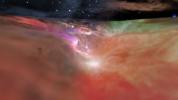
|
-
PIA22089:
-
Visible and Infrared Visualization of the Orion Nebula (Artist's Concept)
Full Resolution:
TIFF
(4.841 MB)
JPEG
(94.93 kB)
|

|
2017-05-10 |
|
Hubble Space Telescope
XMM-Newton
Chandra X-ray Observatory
Spitzer Space Telescope
|
Very Large Array (VLA)
|
1296x1024x3 |
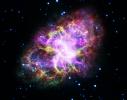
|
-
PIA21474:
-
Crab Nebula from Five Observatories
Full Resolution:
TIFF
(2.823 MB)
JPEG
(119.2 kB)
|

|
2016-01-21 |
|
Hubble Space Telescope
|
Advanced Camera for Surveys
|
3906x3906x3 |
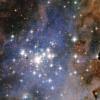
|
-
PIA20468:
-
Hubble Unveils a Tapestry of Dazzling Diamond-Like Stars
Full Resolution:
TIFF
(45.79 MB)
JPEG
(1.43 MB)
|

|
2014-08-27 |
|
Hubble Space Telescope
Spitzer Space Telescope
|
|
3000x2000x3 |
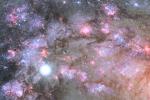
|
-
PIA18471:
-
A Cauldron of Star Birth in the Center of a Young Galaxy (Artist's Concept)
Full Resolution:
TIFF
(18.01 MB)
JPEG
(1.482 MB)
|

|
2014-04-02 |
Helix Nebula
|
Hubble Space Telescope
|
Hubble Space Telescope
|
16000x16000x3 |
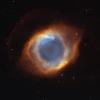
|
-
PIA18164:
-
Iridescent Glory of Nearby Helix Nebula
Full Resolution:
TIFF
(768.1 MB)
JPEG
(27.72 MB)
|

|
2014-01-30 |
|
Hubble Space Telescope
|
WFPC2
|
1005x1005x3 |
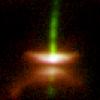
|
-
PIA17835:
-
Dark Disks Around Young Stars
Full Resolution:
TIFF
(3.031 MB)
JPEG
(56.86 kB)
|

|
2013-12-12 |
|
Herschel Space Observatory
Hubble Space Telescope
|
PACS
WFPC2
|
3864x3864x3 |
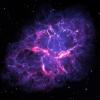
|
-
PIA17563:
-
Crab Nebula, as Seen by Herschel and Hubble
Full Resolution:
TIFF
(44.81 MB)
JPEG
(1.205 MB)
|

|
2013-10-25 |
|
Hubble Space Telescope
|
ALMA
Hubble Space Telescope
|
1762x1762x3 |
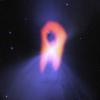
|
-
PIA17551:
-
Ghostly 'Boomerang'
Full Resolution:
TIFF
(9.318 MB)
JPEG
(384.9 kB)
|

|
2013-04-19 |
|
Hubble Space Telescope
|
WFC3
|
2704x2826x3 |

|
-
PIA16008:
-
Hubble Sees a Horsehead of a Different Color
Full Resolution:
TIFF
(18.43 MB)
JPEG
(700.1 kB)
|

|
2013-04-03 |
|
Chandra X-ray Observatory
Hubble Space Telescope
Spitzer Space Telescope
|
Chandra X-ray Telescope
IRAC
Visible-Light
|
3600x3600x3 |
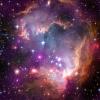
|
-
PIA16884:
-
Taken Under the 'Wing' of the Small Magellanic Cloud
Full Resolution:
TIFF
(38.89 MB)
JPEG
(1.685 MB)
|

|
2012-04-17 |
|
Chandra X-ray Observatory
Hubble Space Telescope
Spitzer Space Telescope
|
|
3600x2880x3 |
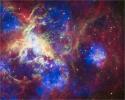
|
-
PIA14415:
-
A New View of the Tarantula Nebula
Full Resolution:
TIFF
(31.1 MB)
JPEG
(1.774 MB)
|

|
2010-07-22 |
|
Hubble Space Telescope
Spitzer Space Telescope
|
|
3000x2400x3 |
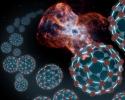
|
-
PIA13288:
-
Space Balls (Artist's Concept)
Full Resolution:
TIFF
(21.6 MB)
JPEG
(422 kB)
|

|
2010-04-22 |
|
Hubble Space Telescope
|
WFC3
|
2104x1937x3 |
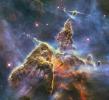
|
-
PIA15985:
-
Hubble Captures View of 'Mystic Mountain'
Full Resolution:
TIFF
(12.23 MB)
JPEG
(530.5 kB)
|

|
2008-08-10 |
|
Hubble Space Telescope
|
WFPC2
|
1502x1482x3 |
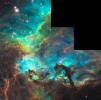
|
-
PIA10957:
-
Hubble Unveils Colorful and Turbulent Star-Birth Region on 100,000th Orbit Milestone
Full Resolution:
TIFF
(6.69 MB)
JPEG
(245.8 kB)
|

|
2007-02-13 |
|
Hubble Space Telescope
|
WFPC2
|
1241x1207x3 |
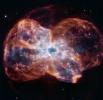
|
-
PIA09194:
-
The Colorful Demise of a Sun-like Star
Full Resolution:
TIFF
(4.499 MB)
JPEG
(153.6 kB)
|

|
2007-01-09 |
|
Hubble Space Telescope
Spitzer Space Telescope
|
IRAC
Multiband Imaging Photometer (MIPS)
|
2394x2571x3 |

|
-
PIA09109:
-
Unwrapping the Pillars
Full Resolution:
TIFF
(18.49 MB)
JPEG
(578.7 kB)
|

|
2007-01-09 |
|
Hubble Space Telescope
Spitzer Space Telescope
|
IRAC
Multiband Imaging Photometer (MIPS)
|
2100x2400x3 |

|
-
PIA09107:
-
Cosmic Epic Unfolds in Infrared
Full Resolution:
TIFF
(15.14 MB)
JPEG
(890.6 kB)
|

|
2006-06-06 |
|
Hubble Space Telescope
Spitzer Space Telescope
|
IRAC
Multiband Imaging Photometer (MIPS)
|
1778x1778x3 |
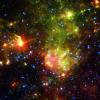
|
-
PIA08516:
-
Dusty Death of a Massive Star
Full Resolution:
TIFF
(9.498 MB)
JPEG
(553.1 kB)
|

|
2006-01-19 |
Helix Nebula
|
Hubble Space Telescope
Spitzer Space Telescope
|
Advanced Camera for Surveys
Infrared Array Camera (IRAC)
|
3125x3497x3 |

|
-
PIA03678:
-
The Mark of a Dying Star
Full Resolution:
TIFF
(32.78 MB)
JPEG
(1.165 MB)
|

|
2005-12-01 |
Crab Nebula
|
Hubble Space Telescope
|
WFPC2
|
3864x3864x3 |
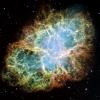
|
-
PIA03606:
-
Most Detailed Image of the Crab Nebula
Full Resolution:
TIFF
(44.79 MB)
JPEG
(1.926 MB)
|

|
2005-11-02 |
|
Hubble Space Telescope
|
WFPC2
|
1518x1497x3 |
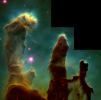
|
-
PIA12108:
-
Embryonic Stars Emerge from Interstellar "Eggs"
Full Resolution:
TIFF
(6.83 MB)
JPEG
(195 kB)
|

|
2004-09-09 |
|
Hubble Space Telescope
|
Advanced Camera for Surveys
|
1417x1417x3 |
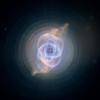
|
-
PIA16009:
-
Dying Star Creates Fantasy-like Sculpture of Gas and Dust
Full Resolution:
TIFF
(5.322 MB)
JPEG
(132.9 kB)
|

|
2003-05-27 |
|
Hubble Space Telescope
|
WFPC2
|
612x792x3 |

|
-
PIA04533:
-
The Red Rectangle
Full Resolution:
TIFF
(870.7 kB)
JPEG
(38.33 kB)
|

|
2003-05-21 |
|
Hubble Space Telescope
|
WFPC2
|
869x444x3 |
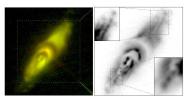
|
-
PIA04277:
-
Hubble's View of a Dying Star
Full Resolution:
TIFF
(635.3 kB)
JPEG
(42.81 kB)
|

|
2003-02-11 |
Dumbbell Nebula
|
Hubble Space Telescope
|
WFPC2
|
1262x750x3 |
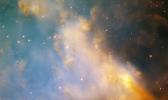
|
-
PIA04249:
-
Close-up of M27, the Dumbbell Nebula
Full Resolution:
TIFF
(2.843 MB)
JPEG
(75.6 kB)
|

|
2000-02-03 |
|
Hubble Space Telescope
|
WFPC2
|
2292x1480x3 |
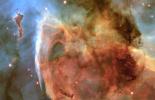
|
-
PIA14444:
-
Light and Shadow in the Carina Nebula
Full Resolution:
TIFF
(10.18 MB)
JPEG
(419.5 kB)
|

|
1999-12-10 |
Hubble -V
|
Hubble Space Telescope
|
WFPC2
|
640x800x3 |

|
-
PIA04222:
-
Hubble-V
Full Resolution:
TIFF
(1.065 MB)
JPEG
(77.99 kB)
|

|
1999-12-10 |
Ant nebula
|
Hubble Space Telescope
|
WFPC2
|
1072x708x3 |
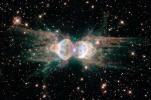
|
-
PIA04216:
-
Ant Nebula
Full Resolution:
TIFF
(2.008 MB)
JPEG
(143.4 kB)
|

|
1999-12-03 |
Ghost Head Nebula
|
Hubble Space Telescope
|
WFPC2
|
674x674x3 |
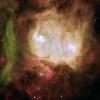
|
-
PIA04226:
-
Ghost Head Nebula
Full Resolution:
TIFF
(1.364 MB)
JPEG
(49.94 kB)
|

|
1999-12-03 |
N44C nebula
|
Hubble Space Telescope
|
WFPC2
|
1460x1502x3 |

|
-
PIA04225:
-
N44C Nebula
Full Resolution:
TIFF
(6.034 MB)
JPEG
(275.2 kB)
|

|
1999-12-02 |
Rotten Egg Nebula
|
Hubble Space Telescope
|
WFPC2
|
843x794x3 |
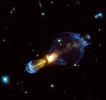
|
-
PIA04228:
-
Rotten Egg Nebula
Full Resolution:
TIFF
(818.3 kB)
JPEG
(56.88 kB)
|

|
1999-12-02 |
Orion Nebula
|
Hubble Space Telescope
|
WFPC2
|
1074x895x3 |

|
-
PIA04227:
-
Orion Nebula and Bow Shock
Full Resolution:
TIFF
(2.805 MB)
JPEG
(61.4 kB)
|

|
1999-12-01 |
Horsehead Nebula
|
Hubble Space Telescope
|
WFPC2
|
853x620x3 |
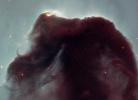
|
-
PIA04215:
-
Horsehead Nebula
Full Resolution:
TIFF
(1.405 MB)
JPEG
(48.75 kB)
|

|
1999-12-01 |
mysterious object
|
Hubble Space Telescope
|
WFPC2
|
3000x2400x3 |
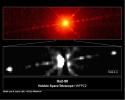
|
-
PIA04214:
-
Mysterious object He2-90
Full Resolution:
TIFF
(6.584 MB)
JPEG
(488.7 kB)
|

|
1999-12-01 |
Doradus Nebula
|
Hubble Space Telescope
|
WFPC2
|
2508x1790x3 |
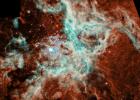
|
-
PIA04200:
-
Doradus Nebula
Full Resolution:
TIFF
(12.24 MB)
JPEG
(608.9 kB)
|

|
1999-01-06 |
|
Hubble Space Telescope
|
WFPC2
|
1215x1241x3 |

|
-
PIA14443:
-
Looking Down a Barrel of Gas at a Doomed Star
Full Resolution:
TIFF
(4.525 MB)
JPEG
(65.37 kB)
|

|
1996-01-16 |
|
Hubble Space Telescope
|
WFPC2
|
1280x1280x3 |
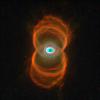
|
-
PIA14442:
-
Hubble Finds an Hourglass Nebula around a Dying Star
Full Resolution:
TIFF
(4.917 MB)
JPEG
(194.2 kB)
|

 Planetary Data System
Planetary Data System

















































